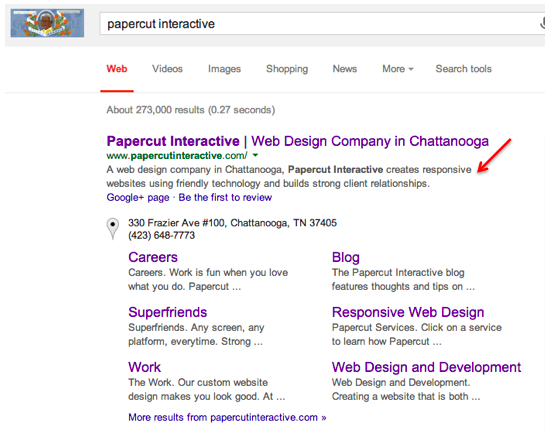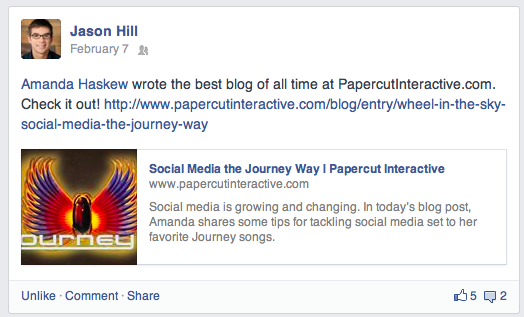Are Meta Descriptions Still Important?

I was recently on a call with a client who requested some help with the meta data on his new website. He was dealing with several product pages and wanted to know how he should craft his page titles and meta descriptions. I was explaining my recommendations and best practices, and halfway through the conversation, he asked, “What’s the value of this?” This caused me to realize that many people probably don’t understand the importance of meta data (and meta descriptions in particular) and that this might be a good topic to discuss here on the Papercut blog.
What Is the Meta Description?
Before we get too far into why it matters, it’s important to understand what the meta description is. In short, the meta description is the snippet of text that appears beneath a link to your website on the search engine results pages (SERPs):

The meta description lives in the code on your website, meaning it’s not visible when a visitor lands on your site. However, because it’s housed in the code, it is visible to search engine spiders. While it plays no role in improved rankings, it does serve an important purpose that I’ll outline below.
Why Should I Care?
While they don’t influence rankings, meta descriptions can influence clickthrough rates. This means that they can help get people from the SERPs to your website. Any good SEO knows that ranking well is only half the battle. You have to get people to visit your site and get them to stay there. A compelling meta description can make your site stand out from the competition, even sites that outrank yours.
It’s also important to realize that if someone shares a link to your site (a page, blog post, etc.) on Facebook, the meta description will appear in the preview on the status update:

This is just one more place where a good meta description can become a big-time traffic driver for your website.
How Do I Write One?
For meta descriptions, the standard recommended length is 155 characters with spaces. The old maximum was 160, and you might still be okay if you go up to that limit, but your description will likely be cut off in the SERPs. So, if you’ve got something important to say (and you should), get it in the first 155 characters.
As far as content is concerned, I advise people to think in terms of unique selling points that will make a user want to click your link. If you’re an attraction website, this could include travel awards or other forms of special recognition. If you’re an ecommerce site, it could be fast delivery and below-retail prices. It’s also a really smart idea to include a call-to-action, such as “Shop now” or “Learn more.”
Things to Consider
In addition to the above guidelines, there are two major things to consider when it comes to meta descriptions. The first is duplicate meta descriptions. Matt Cutts has said that you’re better off with no meta descriptions than duplicate meta descriptions. Unfortunately, websites are sometimes set up to automatically generate a single meta description across multiple pages, creating a problem if unique descriptions aren’t provided. Following Cutts’ advice, the two ways around this problem are 1) writing unique meta descriptions for each page or 2) leaving them blank and letting Google automatically generate them.
The second thing to consider is time and resources. For larger sites, creating a unique meta description for each and every page might be unrealistic. If this applies to you and you can’t write unique descriptions, you can, as suggested above, leave them blank and let Google generate them for you. Andy MacLean wrote a great article on meta descriptions over at Moz, and he also advises that you can work with developers to set up protocols for your meta descriptions. These can be edited and can automatically generate “unique” descriptions. This would probably work best for product pages on an ecommerce site.
Regardless, manually editing these is always preferred, so if you do have the time and resources to dedicate to this, that’s the route I recommend. If you do opt to leave some descriptions blank or automatically generate through protocols, I do recommend creating unique descriptions for your most important pages. These are valuable to your site and are probably your biggest sources of traffic. As such, they should have their own carefully crafted meta descriptions.
The Value
So, back to our client’s original question: “What’s the value of this?” My answer to him was that meta descriptions offer an opportunity to customize additional content on your site and even directly influence the content that appears in the SERPs. Any time the search engines give you the chance to create unique content and drive traffic to your site, you should take it. Unfortunately, meta descriptions have become overlooked by many site owners, who are, in turn, missing an opportunity to reach their audiences while they’re searching.
Do you spend time optimizing meta descriptions? Do you think it’s worth the effort? Let me know your take in the comments.
